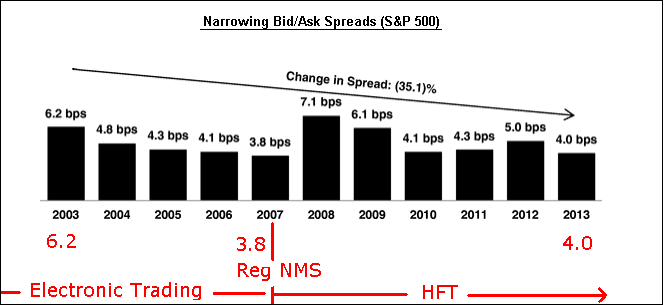Nanex Research

Nanex ~ 1-Apr-2014 ~ Refuting HFT Claims
1. But we provide liquidity!
Ask them to define what liquidity means. Here's the Chairman of the
FIA Europe who completely gets it wrong. Here's an email exchange
with an academic who helped write the SEC flash crash report who also, completely gets
it wrong! Yes, HFT provides liquidity, but only if we are using the term liquidity
to mean something
else.
It gets worse. RBC created a product called Thor specifically to deal with the
fact that HFT were cancelling orders at other exchanges when their market
making software learned that
a large order was in the process of executing.
This means that during the execution of a market order, HFT are able
to cancel their orders at other exchanges. That is not providing liquidity in any sense
of the word.
Micro flash crash events occur when HFT suddenly pull their orders during the execution
of large market orders. Micro flash crash events are
a new phenomenon which first appeared right after Reg NMS
when HFT began. Just a few examples:
2. But we narrow spreads!
It's important to distinguish between electronic trading and HFT, one of
those lowered costs, the other lowered ethics.
Here's a chart from
a pro-HFT camp that clearly shows spreads have not narrowed from HFT. Here's another chart showing the same thing, from the
Virtu S-1 filing no less:

Just a few examples of data showing wider, or unstable spreads:
3. But we lower costs!
SEC Chairman Mary Jo White made this very misleading claim in recent speech (June 5, 2014), which we debunked here (using the same data
and source!).

Many seem to forget that one could trade 100 shares for $8 electronically back in 1998.
Thanks to the internet way back machine, these are easy to find.
HFT proponents also never seem to mention the very real escalation in costs that HFT imposes on
everyone - which are nicely summarized here.

4. But look at all these studies that show HFT is good.
Did you know that most (if not all) of those studies never looks at data sub-second and/or outside a very select group
of stocks? Most focus on just one of 13 exchanges. And with few exceptions, are industry
sponsored.
There's plenty of academic papers, that show harm from HFT, including this one that was
published in Nature.
5. Those (insert expletive here) Nanex guys don't know what they are talking about. Why would
HFT ever want to do X?
We get this a lot, for example, when we published articles about
quote stuffing.
Here's an HFT lobbyist making that
point, and our response.
Nanex Research
Inquiries: pr@nanex.net



